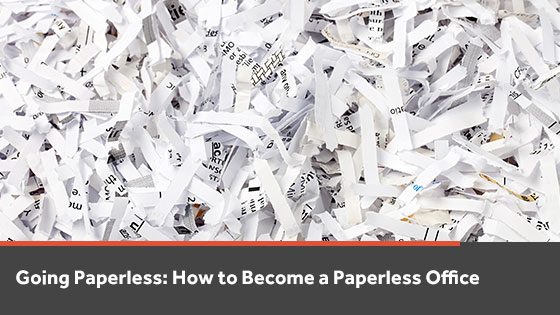Going Paperless: 3 Steps to Start Your Journey to a Paperless Office
December 26th, 2024 | 3 min read
By CJ Porteous

Did you know that the average office worker uses $80 worth of printer paper, toner and paper storage every year? Now multiply that by how many employees work in your office. That’s a lot of money redirected away from the bottom line.
By reducing your printing needs, you can considerably cut costs, and investment can be used for other parts of the business. Plus, in addition to cost reductions, many paperless solutions can actually help employees become more efficient and improve their daily workflows.
As people and businesses become more and more environmentally conscious, paper waste is often an issue that comes up. Offices print a combined number of sheets of paper that adds up to trillions of pages per year. In fact, 50% of all office waste comes in the form of sheets of paper.
The good news is that moving toward becoming a paperless office can have a massive improvement on your business’s environmental footprint while also improving its bottom line.
Taking steps to become a paperless office is a good thing for both your business and the environment. However, actually taking those steps can be difficult. Knowing where the start, what to do, and how to implement this new policy can be daunting.
We’re going to cover some methods you can use to become a paperless office and reduce your paper waste.
1. Find and Stop Wasteful Printing
Becoming a paperless office doesn’t happen overnight. For most offices, reducing printing is the first fundamental step to becoming a paperless office. The easiest way to reduce printing is to identify and eliminate wasteful printing. Are documents being printed only to be shredded shortly thereafter? Not only is this wasteful and harmful to the environment, but it’s a massive waste of money.
One of the best ways to identify wasteful printing processes is by doing a print assessment. A print software running in the background on devices can find and identify poor printing behaviours and problem areas or users.
No training on the software is required, and easy-to-implement solutions can be provided to help you get closer to your goal of becoming a paperless office. A print assessment is an unobtrusive way to find out the cause of wasteful printing and making meaningful, lasting changes.
2. Review Wasteful Business Processes
A business process outlines how a task is meant to be carried out. Businesses create these processes to ensure consistency in their teams. Now don’t get us wrong here, we are massive proponents of codified business processes; clear business processes can create significant value for your organization. The problem arises when business processes are never reviewed or adapted to changing needs and technologies. The business processes of the 90s may no longer be relevant today.
As you review business processes, you should always be looking for ways to reduce inefficiency and redundancy. Does part of a business process requires a document to be printed, signed, scanned, and then emailed? Is there a way to eliminate the printing step? Not only will this business process review reduce wasteful printing, but it will also streamline the entire process and make work flow more efficiently.
As new technologies become available, business processes can be adapted to make use of these technologies. For example, physically signing paper documents or contracts is entirely unnecessary for most businesses and, yet, it is still done frequently in offices around the world. Digital signing solutions are available for clients and employees alike.
Not only does this save paper, but it also eliminates the need for in-person visits to collect signatures. This can save on mileage expenses and give employees more time to actually serve your new customer or go out and find new customers.
3. Change Document Storage Habits
One of the main reasons people still print paper documents is because of antiquated document storage and cataloguing methods. Paper documents are kept onsite or, in some cases, offsite to be consulted when needed.
Not only is this process wasteful, but it’s also inefficient. Employees physically have to search document storage for files when digital options make searching faster and more effective.
A document management system can save paper and money by reducing printing. Employees can easily and quickly share or collaborate on documents without the need to print, mail or travel in person. Plus, if old records need to be referenced, the system is much easier to search than an old file room stacked from floor to ceiling with banker’s boxes.
For a business to truly become a paperless office, it must implement some type of digital document management system. Without this system in place, paper documents will always be required for record keeping.
Become a Paperless Office Today
Are you looking for a deeper dive into reducing printing at your workplace? Our Guide to Controlling Printing Costs examines the questions you need to answer about your print environment if you hope to go paperless, the difference between device management and user management, and much more.
Ready to make the change, save money, and help the planet all at the same time? Request your complimentary print assessment and one of our experts will help you take the right steps to start your paperless journey.
Cory Porteous
Marketing Manager
Office Interiors
Subscribe to Our Blog
Contact Us
If you’re ready to start improving productivity, streamlining processes, and love the way you work through optimized workspaces and office technology, contact us today. Our team of experts is here to help!
Topics:


